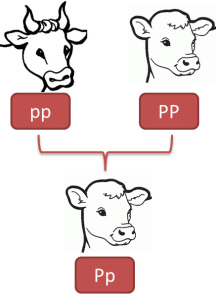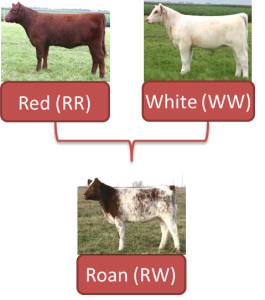Relation between the phenotype and the genotype
Let's start by the example of the polled gene.
If we mate an homozygous bull with two horned alleles (pp) with an homozygous cow with two polled alleles (PP), the calf will be heterozygous Pp and its phenotype will be polled. Hence we have three genotypes (pp, PP and Pp) but we only saw two phenotypes. Therefore, the polled allele (P) is dominant to the horned allele (p) and the horned allele is recessive to the polled allele. When a trait is always observed in the offspring even when a recessive allele is present we speak of complete dominance. However, we don't always observe complete dominance. |
Now, let's take the example of the Shorthorn coat.
When we mate an homozygous bull with two red coat alleles (RR) with an homozygous cow with two white coat alleles (WW), the calf will be heterozygous RW and its phenotype will be roan. Hence, the heterozygote is different from either of the homozygotes. We have three genotypes (RR, WW and RW) and three phenotypes. When both alleles are expressed equally in the heterozygous type, we speak of co-dominance. |
The previous examples illustrated the relation between one gene coding for one trait.
However, the phenotype is a combination of many traits. Therefore, we can arise the question:
What are the expected results for more than one traits?







